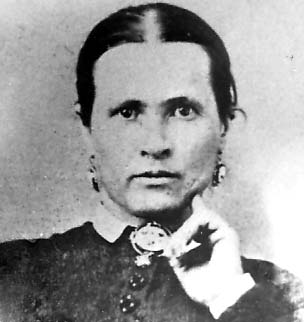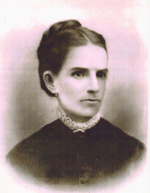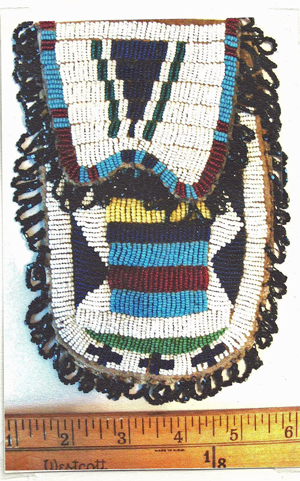2 Jan 1820 – 22 Mar 1904
Husband of Catherine Cardon
History of Moses Byrne
by Alta Byrne Fisher, a great grand daughter
Moses Byrne was born in Northwich, Cheshire, England, January 2, 1820, the son of Denis (O’Byrne) – Byrne and Jane Scarsbrick. Until he was sixteen years old he attended the government school of England and the school of seamanship.

He joined the Navy and followed the sea for about fifteen years as nearly as I can learn. My grandfather, William Byrne, said he had been told that Moses had misrepresented his age when he joined the Navy in order to be accepted and the Navy registers seem to bear this out. The Registers of Seamen at the Public Records Office – London shows – “Moses Byrne, born Northwich, Cheshire – age 21 in 1839.” By 1843…. it shows – Moses Byrne, born Northwich, Cheshire – age 23 in 1843.” He aged only two years in four years. According to this he was in the Navy when he was nineteen. To know how much earlier will take more research.
Moses joined the Church of Jesus Christ of Latter Day Saints (Mormon) in 1853 and in 1854 left England for America, leaving a wife and children behind in England, for what reason I’ve never learned. He sailed from England, April 4, 1854, on the ship, “Germanicus” and crossed the plains in Captain Robert Campbell’s company arriving in Utah October 29, 1854.
Shortly after he arrived in Utah, six days in fact, he married Catherine Cardon on November 5, 1854. She was the daughter of Phillip Cardon and Martha Marie Tourn of Prarustin, Piedmont, Italy. According to emigration records Moses and the Cardons were in the same company as they crossed the plains. These records also indicated there was more than one Byrne in the company as the record states, “Byrne Brothers.”

After he reached the valley, Moses worked for the Pony Express Stations as a contractor for grass hay. Their home base was Slaterville, Utah but the procurement of hay necessitated moving to where grass was available so they moved often, living in tents and occasionally a log house. Catherine cooked for ten men who they employed in their work. He continued to cut hay for a period of ten years.
On December 10, 1859, Moses was sealed to Catherine Cardon and Anne Beus in the President’s Office in Salt Lake City. Anne was also from Piedmont, Italy and was the daughter of Michael Beus and Marianne Combe. Anne came to Utah September 26, 1856 with the first handcart company that came into the valley. (Edmund Ellsworth Company)

Early in 1860, Moses Byrne took a contract from The Overland Stage Company from Denver, Colorado to build stage coach stations on the old emigrant trail through western Wyoming and part of Utah and early in 1861, as nearly as I can tell, he and Catherine moved to Wyoming, leaving Anne in Utah.
Quoting now from Robert C. Byrne – a grandson of Moses Byrne – “These stations were built every fifteen miles beginning at Point of Rocks, Wyoming and going westward into Utah. I don’t know where the last one was built by him. He built one on the Muddy Creek where he also built a toll bridge which he managed for several years. This station was about fifteen miles west of Fort Bridger and where evidence still remains.

He built the cabins mostly of logs which he got from the forests many miles away. He would go to the timber and cut and fit the logs on the spot so that there would be no waste material to haul. He used mostly ox teams to haul with.
He did considerable trading of horses, ox and supplies with the emigrants while he was at the toll bridge on the Muddy. He would often trade one strong fat animal for two that were leg weary and played out.
He would also go to the natural meadows through the country and cut hay with scythes and hand raking it and piling it he would leave it there until winter and then haul it to Fort Bridger where he would sell it to the U.S. government for use there at the Fort.
Just before the Union Pacific Railroad came through there by the station by the toll bridge my grandfather sent for Charles Guild and his wife to tend the station and bridge while he moved three miles father up the Muddy where he was building a store and had contracted some work on the railroad grade and to furnish ties from the Piedmont woods. He started a town here when he built the store and named it Byrne. This name was changed, however, by request of the Union Pacific Railroad because of confusion with the town of Bryan farther east on the railroad. The new name was Piedmont named in honor of the country in Italy where my grandmother, Mrs. Moses Byrne and her sister Mrs. Charies Guild came from.
Piedmont was essentially in Shoshone territory, but there were only two instances of serious Indian trouble. The first occurred while Moses Byrne was still running the Muddy Creek Stage Station. A small hunting party of Sioux rode by and kidnapped Byrne’s two-year-old son Eddie while he was playing in the yard. The Indians moved swiftly and by the time the child was missed, all chances of rescue were gone. Heartbroken, Byrne gave up all hope of ever seeing their son again. One summer day two years later, Chief Washakie rode into the station and handed the stunned Moses his now four-year-old boy. The chief would not tell where he had gotten the child. Eddie Byrne grew up to become mayor of an Idaho town, where he was buried.

The second event occurred one evening at Charles Guild’s ranch. Sixteen of Washakie’s braves broke into the house while Charles was away and threatened to burn the house if Mrs. Guild didn’t give them firewater. While under the pretense of searching for whiskey (she had none in the house) Mrs. Guild managed to sneak her seven-year-old son James out of the house. James rode to the Moses Byrne ranch about a mile and a quarter East of Piedmont, and Byrne, rallying some other men, returned with James and ran the Indians off. Washakie, upon hearing rumors of the raid, promptly came to Mrs. Guild and demanded to know the names of the braves who had frightened her. Although she knew most of them through business dealings with them in her husband’s store, she refused to tell Washakie because she knew his punishment of them would be severe. After her refusal, Washakie had his squaw make a beaded purse for Mrs. Guild and a pair of moccasins for Mr. Guild as a token of his good will.
On March 31, 1871, Moses and Catherine were excommunicated from the church, for just what reason I’m not sure. Moses told his son William, my grandfather, he had broken his leg and was unable to pay tithing and for this he was excommunicated. I told grandfather I doubted this but in 1976 when I visited the archives in Salt Lake City about having his blessings restored I was told that at about that time some excommunications took place for rather insignificant reasons (some because the bishop didn’t approve of the store a person shopped at) and Moses and Catherine may have been in such a situation but I never learned the reason for certain. Maybe the broken leg was the cause. Moses was baptized 19 March 1976, since the date of July 21, 1901, when he came back into the church could not be verified. I had a copy of the Temple Index Bureau card giving this as his baptism date but it could not be found in Salt Lake so the work had to be re-done. The endowment he received in life, together with all sealing and blessings which were received in this life were restored.

The contract Moses made with the Union Pacific Railroad proved to be a very profitable business. The procuring of the ties and poles was quite an operation. The men would go into the aspen groves and cut in the winter and then haul the timbers in the spring and summer into Piedmont with ox teams. There they would load them on the Railroad cars. Later he brought the poles down on Muddy Creek which later became known as the “Tie Drive”. He also engaged in the manufacture of charcoal and the burning of lime in large kilns, in the transportation of which he utilized over fifty teams. The magnitude of this operation and the necessity of the community and his employees caused him to open a mercantile establishment. This business he successfully operated for years and his son Francis took charge of it when Moses retired. He had several ranches and a herd of cattle and horses in the Piedmont area.
The small community of Piedmont grew up around the care and operations of the kilns and the task of bringing the poles down on the “Tie Drive”. Homes were built to accommodate the people employed in these activities along with a school to educate the children.
Simon Bamberger was a hide buyer for a “Hide and Fur” establishment in St. Louis and he bought many hides in the Piedmont area. One winter the snows became very deep and weather was very cold and it became impossible to get his hides into Piedmont to ship them out on the railroad so he remained through the winter in the valley and stayed at the Byrne home. We are told that during this winter he made the suggestion to Moses that they build the charcoal kilns. This suggestion was put into action and became a thriving business with the charcoal product being shipped to the smelters in Utah. The business remained very profitable until the Union Pacific Railroad completed the Aspen Tunnel and then the profits dwindled, people moved away and the once busy community eventually became a ghost town.
‘And the grasses and the flowers withered and the
herds and villages melted way –
In time the wound healed, but a scar was left.”
Robert Carr
He made a trip back to England to visit his brothers who were still living in Liverpool. In later years cataracts developed on his eyes and caused considerable damage.
During all these years his wife Anne was living in Utah. When Moses left for Wyoming she moved from Slaterville to Ogden where she lived in a small home by her father and mother. He made numerous visits back to Utah but didn’t come back permanently. Anne had five children after 1861 when Moses and Catherine left and sometimes had a struggle taking care of them. Can you imagine bearing and caring for these babies with your husband living in Wyoming all the time?
Moses and Catherine moved back to Utah in August 1886 and returned to Piedmont in 1893. While in Utah they built a frame house on Uintah Bench and lived with Anne for a few months while the home was being built. During that time (1890) Ann moved with her family to Idaho where her son Will was already living. Catherine died November 15, 1902 and once more Moses returned to Utah but he returned to Piedmont in 1903 to live with his daughter Alice, who was a widow. Moses died March 22, 1904, age 84, at Piedmont and was buried there. His services were held in the Piedmont school house March 24, 1904 with Bishop Brown officiating.
He had been a very industrious, energetic man who came to America with very little of this world’s material things. My grandmother, Maria Byrne, Moses’ daughter in law, who knew him well, described him as a very pleasant, jovial person; witty, quick of movement and always ready to sing or whistle the tunes of the sea. Somewhat impulsive, he sometimes did and said things for which he was later sorry.
The following is taken from a sketch of Moses Byrne published in the book “Progressive Men of the State of Wyoming” (A.W. Bowen & Co. 1903)
“During the forty years of his residence in Wyoming, Mr. Byrne has steadily and without exception, maintained the character of a worthy, reliable and honest citizen. For years his counsel upon all questions of public interest had been that of the Democratic Party and in its cause he has labored earnestly and well. Fraternally, he is identified with that Ancient Order, The Honored Brotherhood of Free and Accepted Masons, with which he became affiliated in England, the place where he is still maintaining his membership.
His life during the whole of his long residence here has been one of activity, not only in his own interests but in those pertaining to the public as well. He is a representative of that energetic class of men who have made the Western portion of the United States famous on account of their enterprises and determination with which they have undertaken and pushed to completion, plans for betterment of their own and their children’s material condition and also the business and moral interests of the communities where they have resided. None of the present generation has a higher place in the esteem and love of the people, than the honorable and venerable Moses Byrne.
Only the hardiest and the self-sufficient could survive the severe winters and the isolation of the Wyoming area. Living was dangerous not only because of the elements but because of the cattle rustling gangs and vigilante groups. No one was safe from the wrath of these mean ruthless groups. Moses and many others instrumental in conquering this harsh, rugged region, to me are described in this verse by Edgar A. Guest —
“Born for a little while to blaze
In action in the heat of strife,
And then to Shrivel with Time’s blast
And fade forever in the past.
| Joseph Walter | 25 Aug 1855 |
| John Phillip | 31 Mar 1857 |
| James Bartelomew | 26 Mar 1859 |
| Alice | 18 Oct 1860 |
| William Henry | 20 Jan 1863 |
| Charles Lewis | 6 May 1864 |
| Albert | 5 Dec 1865 |
| Edwin Washikie | 31 Jul 1867 |
| Francis K. | 27 Apr 1869 |
| Arthur | 28 Dec 1870 |
| Minnie Catherine | 11 Dec 1871 |
| Mary Jane | 11 Dec 1871 |
| Katie Bertha | 19 Sep 1873 |
| David Robert | 20 Oct 1858 |
| William | 10 Nov 1860 |
| James | 11 Mar 1862 |
| Michael | 23 Nov 1863 |
| Anne | 18 Apr 1871 |
| Moses Louis | 8 Aug 1874 |
| Martha | 13 Apr 1876 |
Footnotes:
1- The spelling of the name Scarsbrick, Jane Scarsbrick, daughter of James Scarsbrick and his wife, Alice, born 27 Oct 1800, chr. 23 Nov 1800, St. Peter, Liverpool, England, taken from the St. Peter printout – P 2027- 1.
2- The following note written by Robert Byrne – ‘At this time 1869 Simon Bamberger came to Piedmont from South Pass, Wyoming and entered into the store business with my grandfather where he ran a dry good department. Mr. Bamberger remained here through the winter and sold his interests. He said he did very well at Piedmont, but decided to go to Utah where he became interested in mines and smelting.
He came back to Piedmont and interested my grandfather in making charcoal for the smelter at Midvale which was, by the way, the first in Utah. This visit with my grandfather led to big timber and charcoal business in Piedmont.”
Byrne Family Cemetery, Piedmont, Wy

